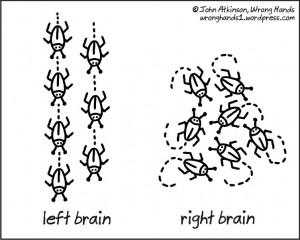
Every time you do a translation, you are creating a unique piece of work. Quoting David Bellos, “Give a hundred competent translators a page to translate, and the chances of any two versions being identical are close to zero.” This is because each of us contributes a unique combination of knowledge, experience, and technique. This post focuses on improving the technique-side of the job by letting the right hemisphere of our brain (and thus valuable inner resources) go on stage.
Left Brain, Right Brain
Most people agree that their best creative ideas strike them while they are in one of the so-called “Three Bs” (bus, bed, bath). Only about 3% of all creative ideas occur at work, with the remaining 97% developing while walking, on the street, hanging around with friends.
The reason why creative ideas sparkle when we are relaxed or engaged in other, most often totally unrelated activities, appears to be that, in those situations, we are using the right hemisphere of our brains more actively. Even when recent research has made groundbreaking discoveries in this respect, and has definitely debunked the myth of “right-brained” and “left-brained” personality types, it has shown that this division of labor allows each hemisphere to work semi-independently and take different approaches to the same problem. While the left hemisphere is more focused on details, the right hemisphere is better at perceiving overall patterns. The left hemisphere is logical, sequential, rational, analytical, and looks at parts, with the right one behaving more randomly, intuitively, holistically, synthesizing, and looking at wholes.
Translating is, after all, more of a creative process than many would think
You definitely need your left hemisphere when translating; grasping exact meanings, finding the right words, ordering them in the correct order are all left-brain tasks. Occasionally, however, even for these tasks, you need to allow your creative side to run free because dictionaries, encyclopedias, and other resources do not always readily provide you with the solution you are looking for. You cannot do an essentially creative job using your left brain only.
For your left brain, everything needs to be black and white. But you know that, when you are writing, trying to give your text a natural flavor, or restructuring a phrase in a more freely fashion so that it will not sound foreign to a reader, you can have a full range of rainbow colors. This drives your left brain absolutely crazy, as it desperately tries to pigeon-hole what you do into black and white. And, of course, it fails. In those instances, your right hemisphere is required to step in.
Has it ever happened to you that you get so caught up in looking for a specific word that you miss the big picture until you take a break and go walk your dog? Or that you wake up right in the middle of the night, and suddenly come to understand what that seemingly inarticulate phrase meant? At those times, you have pushed your left hemisphere into the background, and let the right one step up. Translating involves a lot of thinking, mulling over, and weighing up, and you’ve probably noticed just how much clearer your mind is after a break of some sort, esp. one in which you do not think about work at all. A break appears to be particularly important in improving our ability to have insights (the ‘aha’ moment, when something that did not make sense suddenly becomes clear). It is non-linear problem solving, and that is the way we solve many complex problems.
Unleashing the creative potential of your brain

If what you are doing is driving you nuts, stop the (bullying) left side of your brain and invite your (shy) right hemisphere to work. This will allow you to see the big picture, the connections between isolated pieces of information. You need to find the path to your right brain in order to tackle the same job in a totally different way.
Take a break, if only a small one. Get some rest, you can just lie on the floor and relax your back for a few minutes; it may make a big difference. Alternatively, you can get out of the house for a walk. Go jogging. Jump, run, or otherwise put your body on the move. Do some gardening (this works wonders for me). Or, you can listen to music, or better yet, play it! Or use humor! Laughter sets you free from the tyrannical rule of logic and linearity. You will soon find out what works best for you.
Doing this will allow you to:
Keep a rested mind, so as not to get stuck with the wrong answers.
Keep a quiet mind, to be able to notice the subtle brain signals occurring when you are close to solving a problem by insight (the ‘aha’ moment).
Keep a happy mind, an open mind, which will trigger a broader awareness of internal information, allowing access to the signals immediately preceding the ‘aha’ moment.
Take critical distance— the farther away from an idea, the fewer details you hold in your mind, and the more context you can perceive.
We definitely need both sides of our brain at work. The trick consists in knowing how to easily shift from one to the other.
Images:
1. 5 Tips to Boost Brain Power and Productivity
2. Left Brain, Right Brain, Courtesy of John Atkinson, Wrong Hands
References:
The Truth About The Left Brain / Right Brain Relationship, by Tania Lombrozo, December 02, 2013, Accessed 05 April 2014.
Thinkertoys: A Handbook of Creative-Thinking Techniques, by Michael Michalko, December 2010, Random House LLC
Brain and Realities, by Jay Alfred, 2006, Trafford Publishing
Back From a Vacation? Don’t Waste Your Clear Mind, Published 29 May 2012 by David Rock in Your Brain at Work, Accessed 05 April 2014
How To Stop Your Left Brain From Thinking, by Sean D’Souza, Accessed 07 April 2014
Author bio
Nora Torres is an English-Spanish translator, expert back-translator, localizer, proofreader, quality manager, and linguistic validation consultant. She holds a B.A. in Translation with a Major in Law from the University of Buenos Aires, and has been in the translation industry for over 30 years now. Initially an in-house translator for the largest publicly-held bank in Argentina and a classroom-based and distance-education Teacher of English for International Trade, she became a freelance translator in 1992. Nora was Vice-President of FairTradeNet, a Geneva-based association of freelance translators and, as such, was part of the delegation representing FTN at the World Summit on the Information Society in December 2003. She became a certified life-sciences linguist in 2007 and is currently co-owner of Translartisan, a translation studio specializing in biomedical translation. You can find her on Facebook, Twitter, Pinterest, LinkedIn, or contact her through her website.









7 thoughts on “Tips for Translators: Shift to Right-Brain Mode to Improve Your Productivity at Work”